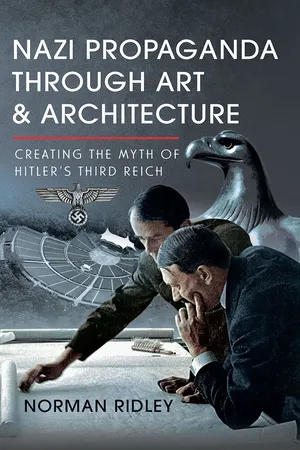
Nazi Propaganda Through Art and Architecture
Creating the Myth of Hitler's Third Reich
- 192 pages
- English
- PDF
- Available on iOS & Android
About this book
When the Nazis came to power in January 1933, they began a program of transforming Germany from a democracy into a totalitarian state, but it was not a matter of simply enforcing compliance. The people had to be coaxed into believing in the new regime. Hearts and minds had to be won over and one of the ways the Nazis did that was to create an ideal of German nationhood in which everyone could feel proud. This was especially the case with art, which came to be used as a powerful tool of propaganda both to disseminate the myth amongst the population and indicate to the Nazi administrators the sort of cultural environment they should create. It was not an easy thing to do. While the nation was being re-created as a dynamic, modern, and powerful industrial giant, all the signals coming from Hitler indicated that his own idyllic view of the German nation was of a traditional, rural people deep-rooted in a romantic-mystical aesthetic. Hitler's own experience as an artist in Vienna before the First World War had shown that, while technically proficient, his work was detached and impersonal. Despite being rejected by the Vienna Academy of Fine Arts he continued to see himself as artistically gifted, especially in the field of architecture. This book looks at how the artistic side of Hitler's personality dominated Nazi aesthetics and the ways in which the Third Reich manipulated public opinion and advanced its political agenda using the power of art. Despite his early setbacks, Hitler always thought of himself first and foremost an artist. He would frequently break off discussions with diplomats and soldiers to veer off on a lecture about his ideas on art and architecture which had been formed during his time in Vienna. Nazi Propaganda Through Art and Architecture explores how Hitler's artistic and architectural vision for Germany led to the monumental structures which we now associate with the Third Reich, alongside the rural idyl he sought to espouse, and how they came to symbolise the re-emergent power of a German nation which would dominate Europe.
Frequently asked questions
- Essential is ideal for learners and professionals who enjoy exploring a wide range of subjects. Access the Essential Library with 800,000+ trusted titles and best-sellers across business, personal growth, and the humanities. Includes unlimited reading time and Standard Read Aloud voice.
- Complete: Perfect for advanced learners and researchers needing full, unrestricted access. Unlock 1.4M+ books across hundreds of subjects, including academic and specialized titles. The Complete Plan also includes advanced features like Premium Read Aloud and Research Assistant.
Please note we cannot support devices running on iOS 13 and Android 7 or earlier. Learn more about using the app.
Information
Table of contents
- Cover
- Book Title
- Copyright
- Contents
- Chapter 1 Nazi Propaganda Techniques
- Chapter 2 Hitler and Art
- Chapter 3 Art in Weimar Germany
- Chapter 4 Art under the Nazis
- Chapter 5 The Good the Bad and the Ugly
- Chapter 6 Artist Outcasts of the Third Reich
- Plates
- Chapter 7 Artistic Champions of the Third Reich
- Chapter 8 The Obsession with Antiquity
- Chapter 9 Propaganda through Architecture
- Chapter 10 Germania
- Chapter 11 Propaganda through Film
- Chapter 12 Propaganda through Music and Theatre
- Postscript Architectural Debate in Post-War Munich
- Appendix 1 Nazi Architecture still to be seen in Berlin
- Appendix 2 Artists in the 1937 Ausstellung Entartete Kunst (Degenerate Art Exhibition)
- Appendix 3 A Guide to the Ausstellung Entartete Kunst exhibition
- Sources
- Notes
- Index
- Back Cover